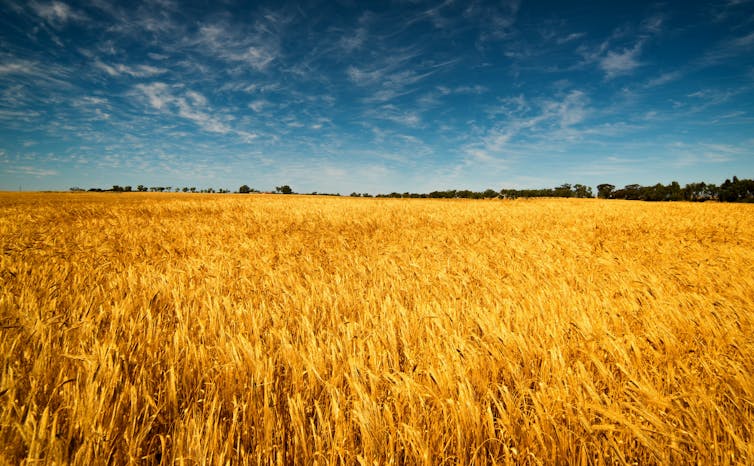
COVID-19 has taken Australia and the world by surprise. Coming after severe droughts in eastern Australia, concerns have been raised about Australian food security.
The concerns are understandable, but they are misplaced.
Despite temporary shortages of some food items in supermarkets caused by an unexpected surge in demand, Australia does not have a food security problem.
An Australian Bureau of Agricultural and Resource Economics and Sciences study released today outlines why Australia is one of the most food-secure countries in the world.
Supermarket shelves reflect a surge in demand
Uncertainties around the impacts of COVID-19 have triggered a rapid increase in purchasing by consumers seeking to stockpile a range of items, resulting in disruption to stocks of some basic food items.
This disruption is temporary and not an indication of food shortages.
Rather, it is a result of logistics taking time to adapt to an unexpected surge in purchasing.
We are highly food-secure
Food security refers to the physical availability of food, and to whether people have the resources and opportunity to get reliable economic access to it.
Australia ranks among the most food secure nations in the world, and is in the top 10 countries for food affordability and availability.
Australians are wealthy by global standards and can choose from diverse and high-quality foods from all over the world at affordable prices.
Most Australians can afford to purchase healthy food that meets their nutritional needs, and as a result, Australia has the world’s equal-lowest level of undernourishment.
We import only 11% of our food
Most food and beverages consumed in Australia are produced in Australia.
But not everything that Australians like to eat is produced here. So we import about 11% of the food and beverages we consume by value.
The imports are mainly processed products (including coffee beans, frozen vegetables, seafood products, and beverages), along with small amounts of out-of-season fresh food.
Imported products account for 11% of expenditure on food and beverages
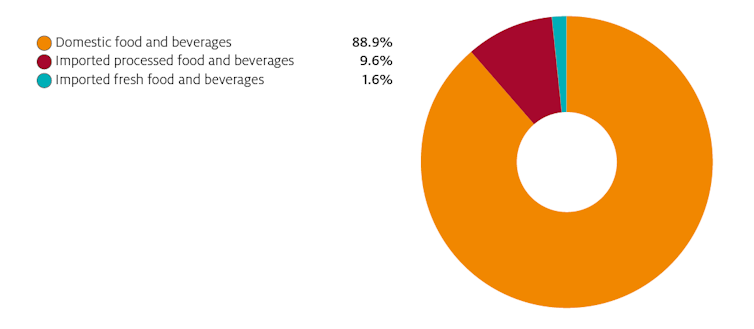
ABS 5368.0, 5204.0
It is possible that disruptions to food imports from COVID-19 (or something else) could result in temporary shortages of some products, restricting consumer choice in the same way as cyclones have restricted access to Australian bananas.
It would be unlikely to have a material impact on food security – in terms of ensuring a sufficient supply of healthy and nutritious food, even if higher prices for or limited availability of specific products disappoints or inconveniences some consumers.
Australia produces more food than it consumes
Australia typically exports about 70% of agricultural production.
The level of exports varies across sectors. Some of our largest industries, such as beef and wheat, are heavily export-focused. Others, like horticulture, pork and poultry, sell most of their products in Australia, with an emphasis on supplying fresh produce.
Most Australian agricultural production is export oriented
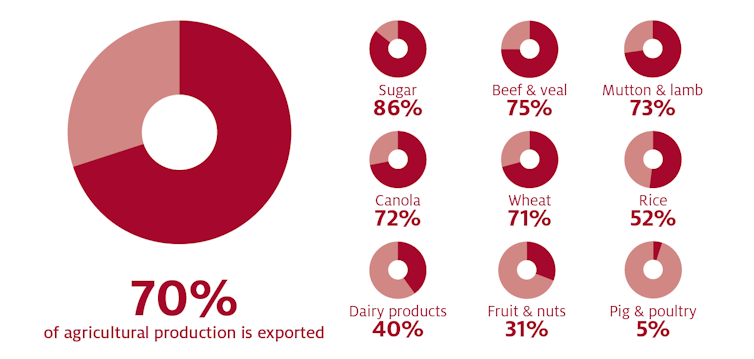
Source: ABARES 2020
Australia’s large exports, even in severe drought years, act as a shock absorber for domestic supply.
They allow domestic consumption to remain stable while exports vary, absorbing the ups and downs associated with Australia’s variable climate and seasonal conditions.
Domestic food consumption is stable, while agricultural exports vary
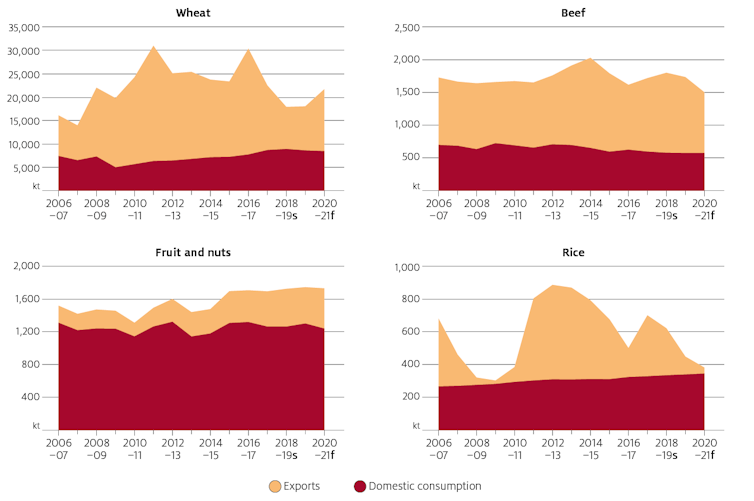
Source: ABARES 2020
The outlook for rain is good
After a hot and dry 2019 and widespread drought conditions in NSW and Queensland, above-average recent rains and positive forecasts provide the basis for the best start to Australia’s agricultural production season in years.
While current prospects for winter crops are good, more rain is required for these to be realised.
The Bureau is forecasting that grain production is likely to return to close to average levels, with a significant chance of higher production given the good start to the winter cropping season.
Wetter than average conditions are likely across agricultural areas from May to July 2020
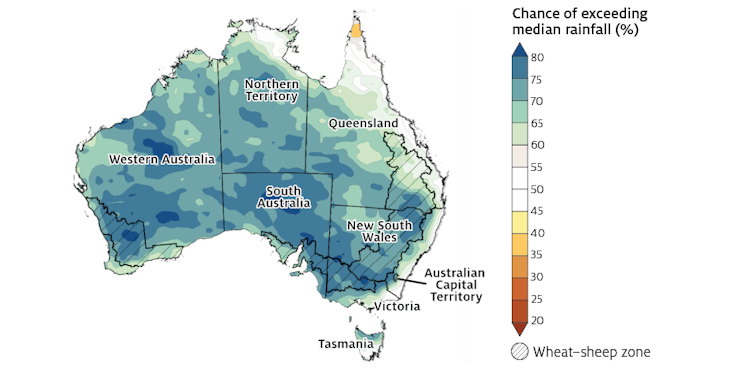
Source: BOM, April 9, 2020
For livestock producers, better seasonal conditions provide the opportunity to rebuild herds and flocks following a relatively long period of destocking.
Our access to food is secure
Australia is one of the most food-secure countries in the world, with ample supplies of safe, healthy food. The vast majority of it is produced here in Australia, and domestic production more than meets our needs, even in drought years.
While we import about 11% of our food and beverages, disruptions to these imports would not threaten the food security of most Australians.
The Bureau of Agricultural and Resource Economics and Sciences is forecasting a return to close to average levels of grain production, with a significant chance of higher production, given the good start to the winter cropping season.
Read more:
Helping farmers in distress doesn’t help them be the best: the drought relief dilemma
The analysis released today explores related issues in more depth, including the contribution of irrigated agriculture to Australian food security, levels of global grain stocks, and the contributions of international trade and Australian exports to food security in other countries.
Australia’s agricultural producers do rely on global supply chains and imported inputs. Shortages or disruptions to these inputs have not yet been significant or widespread, but could reduce productivity and profitability.
While action is already in train to address key issues, it will be important for business and government to continue actively monitoring and managing these risks.![]()
Authors: Steve Hatfield-Dodds, Executive Director, Australian Bureau of Agricultural and Resource Economics and Sciences (ABARES) and Peter Gooday, Acting Executive Director Agriculture, Water, Australian Bureau of Agricultural and Resource Economics and Sciences (ABARES)
Read the latest ABARES Insights paper, ‘Analysis of Australian food security and the COVID-19 pandemic’.
This article is republished from The Conversation under a Creative Commons license. Read the original article.
………………………………………………………………………………………………………………………………………………………………………………………………………………
Rice industry challenges findings
The Ricegrowers’ Association of Australia has taken to task ABARES’ claim in the Insights report that rice shortages are due only to panic buying, and that Australia is not at risk of a supply shortfall.
The association says the report fails to draw on the most recent international developments affecting global rice stocks and trade in response to the COVID-19 pandemic, and fails to recognise the impacts of water policy reform and drought in driving down Australian rice production in 2019 and 2020.
It makes the points that:
- Australia is not currently self-sufficient in rice, and faces a serious shortfall risk.
- Due to water policy and drought, the Australian rice harvests of the last two years represent less than 25 per cent of annual Australian consumption.
- If more water is not made available at cheaper prices between now and the 2020 rice planting window in October, another extremely small Australian rice crop is likely.
- ABARES assumes if the drought does not break, Australia can rely on rice imports instead.
- However, international supply chains are struggling to meet higher than normal demand here and overseas due to the COVID-19 pandemic, widespread drought and locust plagues.
- Some rice exporting nations, including Vietnam, Cambodia and Myanmar, are now restricting exports due to their COVID-19 food security concerns amid persistent drought.
- ABARES relies on International Grain Council forecasts to claim global grains stocks are abundant, based on current national inventories and forecast harvests in 2020-21.
- This ignores the latest developments as described above, where many exporting countries are now holding inventories rather than trading due to domestic food security concerns.
- It also ignores how COVID-19 restrictions on seasonal worker movements may affect how much rice is panted and harvested in the northern hemisphere in 2020.
- ABARES has failed to include an important cautionary note in the most recent International Grains Council’s COVID-19 statement, dated 26 March: ‘The Council’s projections for supply and demand are tentative until the progress and duration of the pandemic become clearer’. https://www.igc.int/en/gmr_summary.aspx
- ABARES has failed to consider how long Australia’s low rice stocks will last at current demand rates. It’s a big assumption to think Australians will stop buying while they eat their way through their panic-bought stocks, and fails to consider what happens after that.
- Australia overall may not be facing a food security issue, but there is a question mark over one staple – rice. Unlike dairy and other cereals, rice can only be irrigated.
- Australian ricegrowers are the most water efficient in the world, using half the global average water per tonne of crop.
- Our rice paddies provide valuable feeding and feeding habitat for waterbirds and animals, including the Australian bittern.
- We are environmentally sustainable, and highly water efficient – but without guaranteed water for 2020, we cannot guarantee Australian households will not run short of rice.
Sources: ABARES, Ricegrowers’ Association of Australia

HAVE YOUR SAY